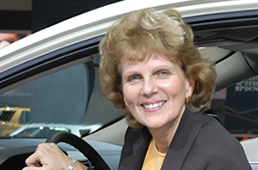Letter from Sue Cischke

"We continue to set a range of sustainability goals and targets. Some are long-term and sweeping, like our goal to reduce the CO2 emissions of our new products in the United States and EU by 30 percent by 2020. Others are more short-term and operational, like cutting our water use by 6 percent by 2010."
Sue Cischke
Group Vice President, Sustainability, Environment and Safety Engineering
It goes without saying that 2008 was a difficult year, not just for Ford but for institutions and people around the world.
It was also a year filled with progress on Ford's sustainability agenda: we introduced exciting new vehicles with best-in-class fuel economy. We accelerated our plan to develop plug-in hybrid electric vehicles and battery-powered electric vehicles. We continued our leadership in vehicle safety and human rights. We took unprecedented steps to further integrate our sustainability strategy into our business operations.
There were also some difficult steps we had to take. We continued to reduce our workforce and close plants to align our capacity to the dramatically reduced global demand for new automobiles.
Because these issues and accomplishments are well documented in this report, I will focus instead on the nuts and bolts of sustainability at Ford: how we are further integrating sustainability into every facet of our business functions and how we are using partnerships and collaboration to advance our sustainability agenda. These are the enablers of continued progress in sustainability through good times and bad.
During 2008, our Board of Directors transformed its Environment and Public Policy Committee – composed of outside Directors – into the Sustainability Committee, reflecting the importance of the full range of sustainability issues to Ford. With this change, we have defined responsibility and accountability for sustainability performance at the highest levels of the Company.
In 2009, we moved the environmental policy function into the sustainable business strategy function, helping to better align our strategy and policy advocacy. The functions I directly supervise have a clear impact on our ability to deliver on our sustainability strategy, but just as important are other key business functions like product development, manufacturing, purchasing and marketing. We integrate and align these functions through the sustainable mobility governance structure. In 2009, we took further steps to ensure that sustainability issues are integrated and managed systematically across functions and regions. These steps included enhancing our sustainability integration forums, including the Global Sustainability Supply Chain Council.
In addition, we continue to set a range of sustainability goals and targets. Some are long-term and sweeping, like our goal to reduce the carbon dioxide vemissions of our new products in the United States and EU by 30 percent by 2020. Others are more short-term and operational, like cutting our water use by 6 percent by 2010. We have established accountability for achieving these goals by including related objectives in the performance plans of individuals. For example, people throughout the product development function are accountable for delivering to product goals and targets, which are evaluated regularly at our senior leadership meetings.
By its nature, tackling sustainability challenges requires collaboration among companies with varying expertise, government agencies, academic experts and others. We have developed or joined partnerships in several key areas.
We continue to work actively through the U.S. Climate Action Partnership, a multi-stakeholder coalition, to advance an economy-wide approach to greenhouse gas reduction in the United States.
Electrification – or the use of electricity to provide most or all of the power for automobiles – is a promising approach for reducing vehicle greenhouse gas emissions. But fulfilling that promise will require cooperation by vehicle manufacturers, electric utilities, regulators and consumers. We are cooperating with Southern California Edison, the Electric Power Research Institute and seven additional electric utility companies in the United States to test the integration of electric vehicles with the electric grid and develop appropriate business models to promote electrification. Also, our collaborative research with BP has helped inform our overall climate change strategy and approach to electrification.
We know that the road ahead will be challenging for our Company. Our financial success and ability to deliver on our sustainability agenda are inextricably linked. We remain firm in our commitment, are proud of the accomplishments we are making toward our goals and look forward to reporting further progress.

Sue Cischke